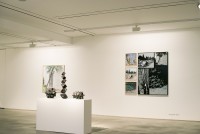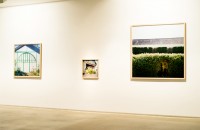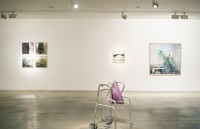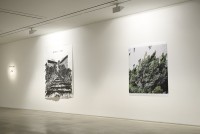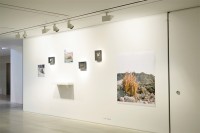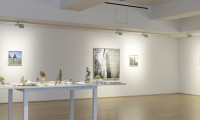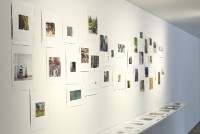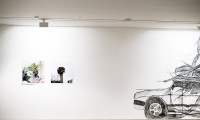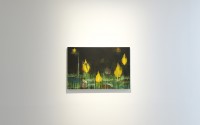Let’s Remain Courteous
In his solo exhibition Let’s Remain Courteous, Yum raises the question of how plants in the city adapt, overcome, and survive human manipulation. Yum, who has always been interested in things abandoned and thrown out around us, captures the plant life in the man-dominated metropolis. And through these plants, contemplates on a so-called courtesy in coexistence.
The title of this exhibition, Let’s Remain Courteous, is the name of a group exhibition in Michel Houellebecq’s novel, La Carte et Territoire, to which the protagonist is invited. “Let’s Remain Courteous” at HITE Collection presents photographs by Joongho Yum, capturing plants in an artificial environment, as well as works in collaboration by 7 different artists: Seokho Kang, Kyunghwan Kwon, Suyoung Kim, RohwaJeong, Lionel Sabatté, Jina Park, and Dae Jin Choi.
Yum’s Photography about Plants
This exhibition presents about 40 pieces of recent works by Yum that depict plants in the city environment. Yum often thinks plants are similar to animals in that their lives are both dominated by humans, that is, plants are so tamed, reconstructed and transformed to suit mankind’s appetite, as are animals, losing their wildness.
Plants must adapt to the environment presented by man. To survive in the city, plants are conditioned to suit new surroundings, having relocated from their natural habitat. The plant exists less, and even appears limp. Questioning the survival tactics of plants, Yum began this work imagining that plants have many such tactics to live in the city. Taking a closer look at dying and abandoned plants, at times they carry the liveliness as if a new plant comes to life, and at other times, arouse sadness.
The power struggle between man and plants is easily overlooked but forever ongoing. The plant’s position in the relationship with mankind may seem subjugate, but this is not always the case. Rather than showing the plant’s life as it is, or directly expressing their struggle for life, he hopes to comment and express interest in the special shape of the surroundings in which the plants lie, and merely becoming an observer. In the end, he is troubled about the ways in which we can be courteous to plants. He wishes to remain courteous to them.
The plant within the industrialized society, especially the city, resembles man himself or animals placed in the same situation. The logic in creating and preserving our environment and system for the needs and desires of the individual and society; the ethics in supporting such an infrastructure through everyday routine; and all in all, man-oriented humanism are proof that the relationship between the stakeholders (man vs. plants) is utterly incomplete and insensible. Whether this circle of life is considered fate or fortune or simply, a way of life, the plant cannot help but to continue in this struggle. But as is written at the end of the novel, nature, in the end, belongs to nature, and humans should learn to live in it. After all, it is human, not any particular society or its system, that is promised eternity.
These ideas have become the basis for the artists’ set up for this particular exhibition.
Works in Collaboration with 7 Other Artists
Joongho Yum plans to display his photographs along with the works of seven other artists. The collaborating artists are Seokho Kang, Kyunghwan Kwon, Suyoung Kim, RohwaJeong, Lionel Sabatté, Jina Park, and Dae Jin Choi. After sending all other artists except Jina Park his photos to be exhibited, he corresponds with them about the work, exchanging the imaginative process. Jina Park does not choose a specific image from Yum’s works; she instead produces a work of drawing series by exchanging her drawings with Yum. Each process between Yum and each artist allows for various exchanges and developments in each of the works, and allows for the whole of the exhibition to become a space for a reinterpretation of images.
The motif for this project was “plants.” Seokho Kang’s work displays Yum’s works in grey tone. This work, unlike his previous works, was specifically made for this project and therefore is most likely to be disposed after this exhibition. Kang took a specific image in Yum’s works and developed it using a different medium, making the original image fade away to find new meaning. Kyunghwan Kwon took Yum’s photos and redrew them with paint.
Similarly to Seokho Kang, Suyoung Kim used the disappearing image technique by taking Yum’s images evoking lethargy and emptiness to recreate them through drawings using her imagination. This is an attempt to see the results of an “encounter” as the actual subject.
RohwaJeong says “the plants that surround us and live near us seem all to have similar qualities.” Both landscape plants and potted plants are reformations in which the root has been relocated from the original soil. Their works are reproduced in the form of a park made of paper trees.
Lionel Sabatté makes the shape of a rose using human nails. Collecting the nails clipped off of people’s fingers, they are recreated into a flower and a butterfly. He chose a working technique that can coexist with Yum’s theme, among his own works.
Jina Park works by way of exchanging letters of drawings. Yum usually works exclusively with photographs by camera, and even for Jina Park, this was an unfamiliar method. The last step of this collaboration was an attempt to connect via a method neither of them used, that is, by exchanging drawings.
Dae Jin Choi considers Yum’s plant photographs to be “not plants as objet d’art, but organic matters very much relevant and responsive to its surroundings.” He attempts to create another image by metaphorically interpreting the plants’ presence.
Iles Flottantes (Floating/Drifting Islands) Project
Joongho Yum interprets his images through collaboration with other artists and writers. Many producers, writers, and novelists (Hong-Goo Kang, Taeyong Kim, Dongjin Seo, Jean-Claude Moineau, Yoo-Joo Han, Siwon Hyun) have taken Yum’s images to interpret in different ways, using their own ways of conceptualizing. Such interpretations have, in the form of writing and images, have been compiled to become a book in Workroom. The title of the book is Iles Flottantes (Floating/Drifting Islands) and along with this exhibition Let’s Remain Courteous, is an image interpreting project for Joongho Yum and his collaborators.
